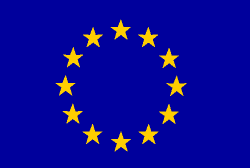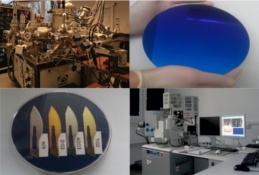 |
Institute of Physics 1953-2013
Review of research activities
 • Semiconductors • Semiconductors
 • Molecular Physics and Optics • Molecular Physics and Optics
 • Magnetism and Superconductivity • Magnetism and Superconductivity
 • Crystal Defects • Crystal Defects
 • Biological Physics • Biological Physics
History of the Institute of Physics (1953-2000)
The Institute of Physics was founded in September 1953. At this time it came into being as a legal entity and was conferred a budget and premises in Warsaw by the government. This was at the urging of the Polish Academy of Sciences (PAS), the national scientific institution established a year earlier. In November 1952, PAS had adopted a resolution to create the Institute of Physics, with a mission to "conduct scientific research in experimental and theoretical physics, in areas especially important for the national economy, as well as to educate scientific staff."
The creation of PAS, a new, centralized science organization in postwar Poland was motivated, on the one hand, by the need for improved management and development of the modest scientific potential remaining in the country after the devastation caused by war. On the other hand, it arose from an ideological premise that ruled at the time in all the Soviet Bloc - for all its member countries to adopt the science organization model implemented beforehand in the USSR. The opinion of scientific societies and institutions was also of importance. They had expressed the need for a uniform organization of science in the whole of Poland immediately after the war as well as during German occupation.
The scientific personnel of the Institute of Physics were drawn from the, mainly prewar, physics faculty of the leading Polish academic institutions: The University of Warsaw, Warsaw University of Technology, Jagiellonian University, AGH University of Science and Technology, Adam Mickiewicz University in Poznań, as well as Wrocław University of Technology and Nicolaus Copernicus University in Toruń. The latter two institutions were established after the war based on those who had survived from the prewar academic cadre of Vilnius and Lvov. The grounds and facilities of the university departments listed above were also the initial home of the new institute. Several other research institutes founded in this period by PAS arose in a similar manner.
In the intention of the organizers - Professor Stefan Pieńkowski, the first director of the Institute, and Professor Leopold Infeld, the first chairman of the scientific council - the Institute was to become a leading, nation-wide scientific center conducting basic research on the highest level in all current fields of modern physics. Other tasks for the institute included the teaching PhD students, organizing new scientific institutions, and transferring research results to industry for applications. In the language of the political leadership at the time the latter requirements were expressed as: "it is necessary to plan and conduct such studies as are needed to secure a better living standard".
After the death of Stefan Pieńkowski, shortly after his appointment to director of the newly established Institute, Professor Leonard Sosnowski took over the position and in 1954 became the first acting director of the Institute. His personality, scientific interests, the broad education and experience gained in British laboratories prior to and after the war, and his organizational talents left an indelible impression on the further development of the Institute both during his 12 year term in office as director, and afterwards, when he chaired the scientific council. Among his most important achievements were the management of the development of the Institute into an active and creative scientific center, the organization of top level scientific research, and education of its future scientific cadre - something that was especially important in the first decade of the Institute's operation, in the politically and economically difficult period of early communist Poland. His lasting achievements also include the establishment and maintenance of contacts with leading scientists and research centers in the Western World, which were crucial at the time for the existence and the operation of the Institute.
In 1955, following the appointment of the Government Commissioner for Nuclear Energy Development and the founding of the Institute of Nuclear Research, the Warsaw and Kraków based laboratories of nuclear and elementary particle research withdrew from the Institute. With this, the primary research profile of the Institute that continues to this day was established, concentrating on condensed matter physics and characterization methods, as well as radiation physics with spectroscopy, and atomic and molecular physics.
Also in this time period (1954-1957) several new laboratories and departments of the Institute were set up in Warsaw, Toruń and Wrocałw, which later developed into separate scientific institutions. Among them were the Department of Dielectrics in Poznań headed by Prof. Arkadiusz Piekara, a later director of the Institute (1966-68) which in 1975 became the Institute of Molecular Physics PAS, and the Department of Low Temperature in Wrocław headed by Prof. Ingarden. The latter, together with the Department of Physical Chemistry Structure Research headed by Prof. Włodzimierz Trzebiatowski, formed the Institute of Low Temperature and Structure Research PAS in 1966. The initial formation period of the Institute was crowned in 1957 with the opening of its first own, yet still temporary, seat in the reconstructed edifice of the prewar telephone exchange "PASTA" on Zielna Street, in the Warsaw city center. This building housed the management, administration, technical facilities, and a few of the laboratories. In the six years since the founding of the Institute the number of its employees had increased fourfold, to nearly 200 by the end of 1959. In that same year the Institute became entitled to award doctor and habilitation (docent) degrees in physics.
In the 60's, the technical department of the Institute played an important role in its experimental research. It functioned also as the manufacturer of laboratory and measurement apparatus. Due to the economic autarchy, the lack of an exchangeable currency, chronic shortages on the market, and the embargo on sale of modern technologies by western countries to the Soviet Bloc, the purchaseof not only specialized but also basic laboratory equipment was practically impossible. The progresses in manufacturing of such equipment at the Institute lead in 1962 to the establishment of the UNIPAN enterprise, which was formed on the basis of the laboratory for electronic and measurement apparatus. In 1972 the Institute created three further experimental labs manufacturing scientific equipment: WILMER, UNIPRESS, and RADIOPAN.
The research directions followed at the Institute in the 50's and 60's, as part of its overall scientific profile, consisted of problems that were of interest to the scientific group leaders in their alma maters, or were imposed by the needs of state-owned industry. Strictly scientific studies that generally reflected the world mainstream were possible thanks to more or less regular access to the foreign scientific literature and personal contacts with colleagues abroad. The formally stated state regulated research programs were conducted as part of the State Plans for Development in Science and Technology. These programs mostly addressed the current needs of the growing electronic, machinery, and armaments industries, and were directed particularly towards the solution of technological problems. From the beginning of the 60's, decision-making circles in the state administration showed increasing interest in semiconductor technologies, owing to the developing diode and transistor production sector. This opened a chance to connect basic research with the needs of industry, and moreover enabled the Institute to obtain additional funding for research, including basic research. The physics of semiconductors, the technology of their growth and characterization, have since become the main research topics in the Institute, leading to many achievements in this field. The second important research field, also related to industry, was the physics of magnetic materials, and their domain properties, applicable for data storage.
The decade of the 70's was a particularly important period for the development of the Institute, which for the first time in its history moved to a modern abode adequate to its needs - situated on Aleja Lotników, in the Służewiec district of Warsaw. Due to the more progress-oriented economic and science politics of the group that came to power in the country after 1970, the Institute also obtained substantial additional financial means for the acquisition of modern scientific equipment abroad. Moreover, loosening of the passport control politics gave the Institute the opportunity to broaden its scientific contacts with the West. In 1970 the position of the director of the Institute was taken by Prof. Jerzy Kołodziejczak, the former vice-director and head of the Department of Condensed Matter Spectroscopy, a student of Prof. Sosnowski. His 12 year term in office was characterized by substantial development of the Institute's experimental resources, the fostering of new research directions, as well as the introduction of several more modern measurement techniques. There was a considerable increase of the size of the scientific cadre (more than 600 employees in 1974) and a notable expansion of international scientific cooperation. The Institute had become an important national and later also international, center of semiconductor research.
In 1973 the internal organization structure of the Institute was changed. The previously numerous small departments and labs were consolidated into large scientific divisions. Originally there were three of these, while the fourth one was created after 1978. The labs were consolidated into large single Laboratories where the leading measurement apparatus was brought together. The organizational structure introduced at that time has existed until the present.
The Institute also attracted an increasing number of physics alumni and postgraduate students in the 70's. Many of them form the backbone of the Institute's present scientific cadre while over twenty former employees or PhD students are now professors at American and European universities.
One of the most important scientific specialties that the Institute entered into at the end of the 60's and in the 70's is research into narrow-band-gap semiconductors, and later, diluted magnetic semiconductors. These fields have also been the areas of greatest scientific achievement of the Institute, when measured by the numbers of citations, publications, invited lectures, and scientific awards.
In the 80's, an especially difficult period both politically and economically, the Institute lost many of its employees and, for a certain time, even the scientific connections to the international community. The inflation and trade restrictions rampant in this period led to the pauperization and depreciation of a part of the technical base, the delapidation of buildings, and limited the possibilities to conduct experimental studies. The directors of the Institute in those times, Prof. Jerzy Prochorow (1981-1987) and Prof. Henryk Szymczak (1988-1997) made every effort and often performed wonders striving to maintain a high scientific level, to secure material facilities, and to safeguard the Institute against the consequences of political and economic disturbances.
The period immediately after the political transformation of 1990 required the mastering of an entirely new economic environment, new administration methods, a new organization of science, and most of all, learning to operate under the conditions of a competitive economy. The most visible consequences of these changes was the drift of young employees to private enterprises and the diminishing attraction of the physicist profession for talented students. Nevertheless, the Institute has succeeded in maintaining its high scientific standards, as has been evidenced by its impressive record of success in winning domestic and international competitive research grants, and the growing number of foreign postdocs and PhD students.
One of the important consequences of the political transformation of 1989/1990 was the opening of access to international technologies and equipment for the fabrication and study of low dimensional structures. Low dimensional systems have dominated world semiconductor research since even the 70's, beginning with metal - insulator - semiconductor (MIS) structures, in which the quasi two-dimensional electron gas induced near the semiconductor/insulator interface was controlled by metal gate voltage, through quantum wells and superlattices grown by molecular beam epitaxy (MBE) or metal-organic chemical vapor deposition (MOCVD). Unfortunately, in those years, the latter methods were inaccessible in Poland due to the import embargo as well as a simple lack of funds. Hence, in the 70's and 80's the Institute's research on 2D systems was restricted to rather primitive MIS structures, fabricated with home-made methods. Since these structures could not compete with those grown by epitaxial technique, the Institute undertook efforts to construct an MBE system in its own mechanical workshops. The construction work was supervised by Prof. Marian Herman, the later Deputy Director for Scientific Affairs of the Institute. Although the machine was not competitive with those commercially available abroad, many thin layers and quantum wells were produced. This home-made MBE system is employed to this day in the group headed by Prof. Tomasz Story, after being upgraded with more efficient vacuum pumps and commercial effusion cells.
The new situation after 1989 and the world wide drop in price for commercial MBE systems presented the possibility to acquire such a machine. In 1993 on the initiative of the management, Professors Henryk Szymczak and Henryk Lachowicz organized the purchase of an EPI MBE system with six effusion cells. It entered service in the group headed by Prof. Jacek Kossut. The original construction has evolved over the years, with many improvements introduced by the scientists utilizing the instrument. To date it has produced well over 3000 structures. Nowadays not only two dimensional structures, but also nanowires and self-organized quantum dots are being grown. The group specializes in structures containing transition metal ions displaying magnetic properties. Doped CdTe- and CdMgTe-based structures grown by the groups of Prof. Tomasz Wojtowicz and Prof. Grzegorz Karczewski achieve the highest electron mobility in the world and are highly regarded by the many research groups collaborating with the Institute world wide - in Japan, Germany, Great Britain, France, Russia, United States, and Korea to name a few. Many of the published results on these topics were obtained in cooperation with the group of Prof. Jan Gaj at the Institute of Experimental Physics of the University of Warsaw. A selection of them can be found described in the book: "Introduction to the Physics of Diluted Magnetic Semiconductors", eds. J. Kossut and J. Gaj, Springer Verlag, 2010.
In addition to the growth of low dimensional semiconductor structures, the Institute has also developed molecular beam epitaxy (MBE) of thin metallic layers, inspired by the giant magnetoresistance phenomenon discovered by German and French scientists in sandwich structures consisting of two ferromagnetic metal layers with a nonmagnetic metal spacer. Such structures have revolutionized data storage and processing and form the basis of the new generation of logic devices. The discoverers of the giant magnetoresistance effect were recently awarded the Nobel Prize in Physics. Research in this field at the Institute has been conducted by Dr. hab. Lech Baczewski and Dr hab. Andrzej Wawro, with coworkers.
Reduction of the effective dimensionality of physical systems can also be implemented with lithography. The optical lithography used in microelectronics is not sufficient to enter the present-day state of the art nanotechnology. Instead, either deep ultraviolet or electron beam lithography is required. The first setup of this kind at the Institute was installed in the Laboratory headed by Prof. Tomasz Dietl in the mid 90's. The structures produced with the use of that system enabled the observation of the Stern-Gerlach effect for conduction electrons, which was previously considered impossible to achieve. Nowadays, two electron beam lithography systems are in operation at the Institute (a second was installed in the years 2011-2012).
In 2004 the Institute expanded its research into the domain of Biological Physics, and a new research unit was created under leadership of professor Marek Cieplak, to undertake theoretical and experimental studies in that field.
The contemporary era in the Institute's history began with Polish accession to the European Union and the resulting integration of the Institute with the European Research Area. The most visible and spectacular element of this process was the opening of access to Structural Funds and other EU programs directed towards the development of research infrastructure. A number of the Institute's laboratories have been completely renovated and equipped with modern facilities. Several MBE systems, a modern electron microscope, and equipment for surface diagnostics and imaging with atomic scale resolution were purchased. The Laboratory of Biological Physics was established from scratch. A second important element of this new era is the uninhibited access of the Institute's employees to the largest European research infrastructure, such as synchrotron radiation and high magnetic field laboratories.
In October 2013 the Institute celebrated its 60th anniversary, under honorary patronage of the President of Poland Bronisław Komorowski. On this occasion the achievements of the Institute were recognized by the State and Academy of Sciences authorities: Seventy of our scientific and technical staff were decorated by various state medals.
|  |


















